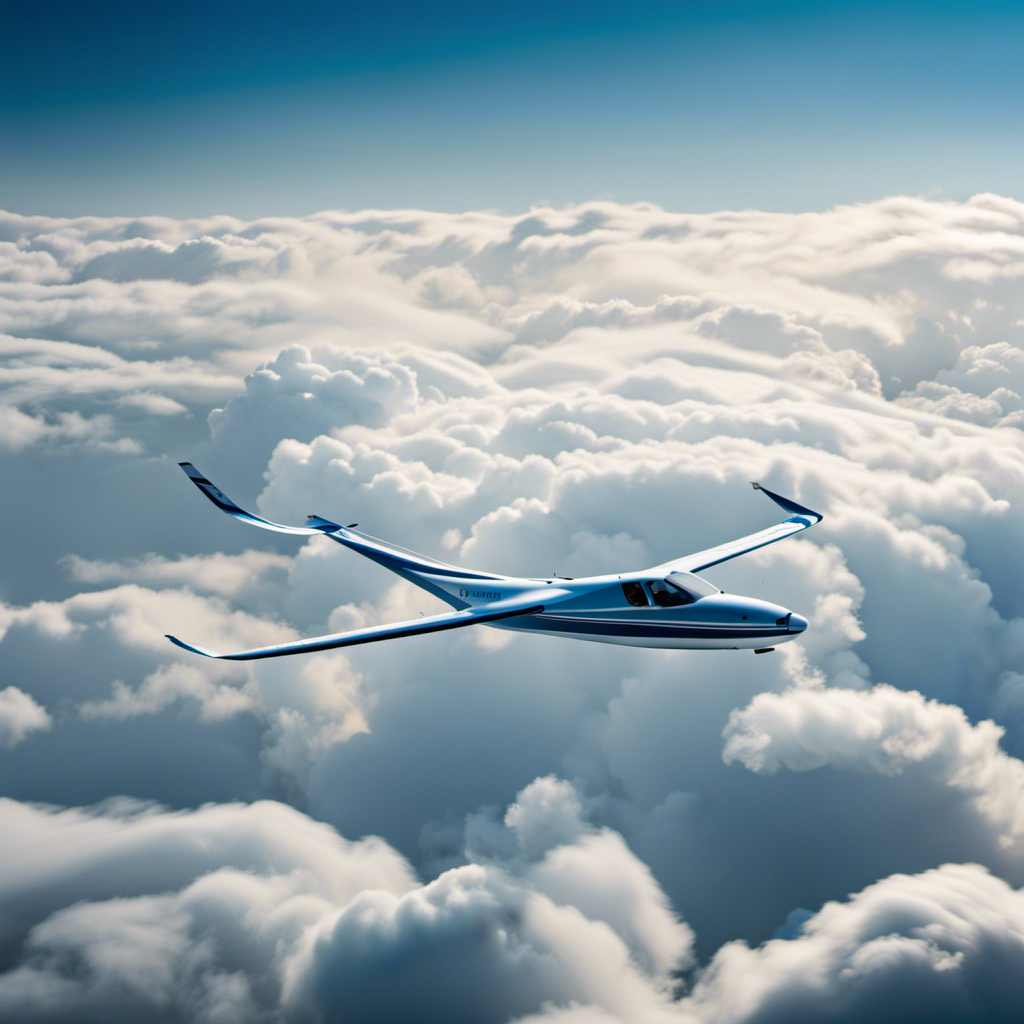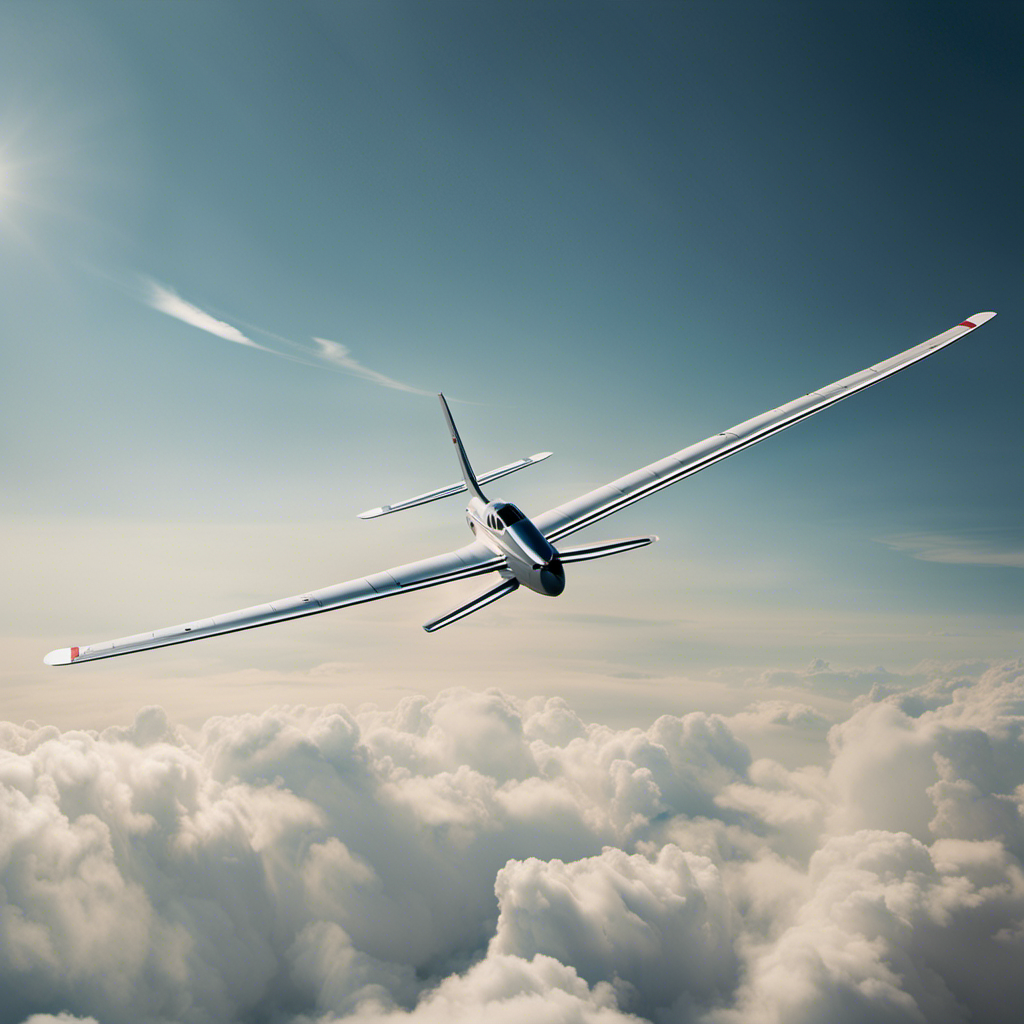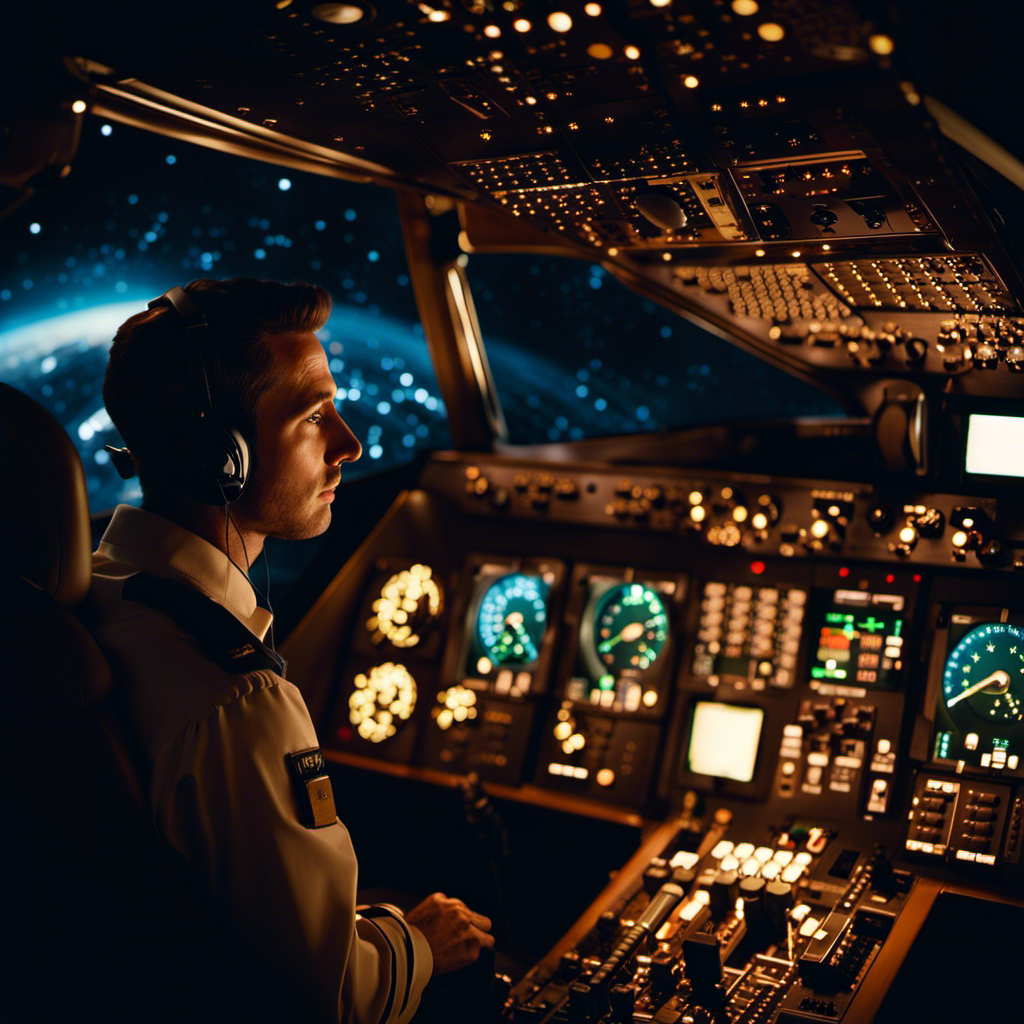Did you know that the Boeing 747, one of the largest commercial jets in the world, has the capability to glide? Yes, if its engines were to fail, this massive aircraft can gracefully glide through the air.
In this article, I will delve into the science behind gliding and explore how the Boeing 747 is specifically designed to execute this maneuver.
We will also debunk myths and misconceptions about gliding and discuss future developments in gliding technology.
Get ready to soar into the fascinating world of gliding with me.
Key Takeaways
- The design features of the Boeing 747 contribute to its effective gliding abilities.
- Gliding techniques and emergency landing procedures are crucial in engine failure scenarios.
- Understanding glide ratios and factors affecting glide distance is essential for maximizing coverage.
- Simulator training plays a vital role in preparing pilots for engine failure scenarios and emergency procedures.
The Science of Gliding
Did you know that when it comes to the science of gliding, understanding the principles of aerodynamics is crucial? Gliding techniques rely heavily on the application of aerodynamic principles to achieve sustained flight without the use of an engine.
By harnessing the forces of lift, drag, thrust, and weight, gliders are able to stay aloft and maneuver through the air. The shape and design of the glider’s wings, along with its control surfaces, play a significant role in generating lift and controlling the aircraft’s movements.
How a Boeing 747 is Designed to Glide
When discussing the wing design and lift generation of a Boeing 747, it is important to consider the aircraft’s unique features.
The 747 utilizes a swept-wing design, which helps to reduce drag and increase lift efficiency. Additionally, the aircraft incorporates various high-lift devices such as flaps and slats to enhance lift during takeoff and landing.
Moving on to flight control systems, the 747 incorporates a sophisticated system that includes hydraulic actuators, fly-by-wire technology, and an autopilot. These systems work together to provide precise control and stability throughout the aircraft’s flight envelope.
Wing Design and Lift Generation
You’ll be interested to know that the wing design and lift generation of a Boeing 747 allows it to glide effectively.
The glide performance of an aircraft is primarily determined by its wing shape. In the case of the 747, it features a high aspect ratio wing, which means that its wingspan is significantly greater than its chord length. This design enables the aircraft to generate more lift and have a higher glide ratio, allowing it to travel a longer distance horizontally for a given altitude loss.
The wing shape also incorporates winglets, which reduce drag and improve efficiency. These features, combined with the powerful engines, contribute to the 747’s ability to glide and maintain control during emergency situations.
Transitioning into the subsequent section, the flight control systems play a crucial role in maneuvering the aircraft during gliding scenarios.
Flight Control Systems
The flight control systems on the 747 are essential for maneuvering the aircraft during emergency gliding scenarios. These systems include the ailerons, elevators, and rudder, which provide control over the roll, pitch, and yaw of the aircraft.
During a glide, the flight control systems play a crucial role in maintaining stability and control. By manipulating the control surfaces, pilots can adjust the glide performance of the aircraft, controlling its descent rate and direction.
The flight control systems work in conjunction with the wing design and lift generation to optimize the glide performance of the 747.
In the event of an engine failure, these systems become even more critical, as pilots rely on them to maintain control and safely navigate the aircraft to a suitable landing site.
Engine Failure Scenarios
In certain engine failure scenarios, a Boeing 747 can still glide. When faced with such a situation, the pilot must employ specific gliding techniques and emergency landing procedures to ensure the safety of the aircraft and its passengers.
Gliding involves carefully managing the aircraft’s altitude and airspeed to maximize the distance it can cover without the use of engine power. By adjusting the pitch and attitude of the aircraft, the pilot can control the glide ratio and descent rate. These techniques, combined with proper navigation and coordination, allow for a controlled descent towards a suitable landing area.
Understanding the capabilities and limitations of the aircraft, as well as practicing emergency procedures, is crucial in these situations. Transitioning into the subsequent section about glide ratios and distances, it is important to analyze how these factors affect the overall gliding performance.
Glide Ratios and Distances
After discussing the various engine failure scenarios, let’s now delve into the topic of glide ratios and distances. Understanding the glide performance of a Boeing 747 is crucial for emergency procedures in case of engine failure.
-
Glide Ratio: The glide ratio refers to the distance a plane can travel horizontally compared to the altitude loss. A higher glide ratio means the aircraft can cover more ground while descending.
-
Glide Distance: The glide distance is the maximum distance an aircraft can cover while gliding before it touches the ground. This distance depends on factors like altitude, airspeed, and wind conditions.
-
Speed Management: During a glide, maintaining the appropriate airspeed is vital to optimize the glide performance and maximize the distance covered.
Analyzing the glide ratios and distances of a Boeing 747 helps pilots determine potential emergency landing sites. These sites are strategically chosen to ensure the safety of passengers and crew.
Emergency Landing Sites
When considering emergency landing sites, you need to assess factors like accessibility, terrain, and proximity to emergency services.
Emergency landing techniques and training play a crucial role in ensuring the safety of both passengers and crew in the event of an unforeseen emergency. Pilots undergo rigorous training to handle various emergency scenarios and execute emergency landings with precision. This training equips them with the necessary skills to assess and select suitable landing sites based on several factors, including the aircraft’s capabilities and the surrounding environment.
By evaluating the accessibility of potential sites, the terrain conditions, and the proximity to emergency services, pilots can make informed decisions in critical moments. As such, emergency landing training is an essential component of pilot education and preparation.
Transitioning to the subsequent section on pilot training and simulations, it is crucial to understand the role that these simulations play in enhancing pilots’ emergency landing skills.
Pilot Training and Simulations
Simulator training plays a crucial role in preparing pilots for engine failure scenarios and practicing emergency procedures. Through realistic simulations, pilots can experience the challenges and complexities of dealing with engine failures in a controlled environment.
This training allows pilots to develop the necessary skills and decision-making abilities to safely handle emergencies, ensuring the best possible outcomes in real-life situations.
Simulator Training for Engine Failure
Pilots receive simulator training for engine failure scenarios. This type of training is crucial as it allows us to practice and refine our emergency procedures in a controlled environment. The simulator provides a realistic simulation of various engine failure scenarios, allowing us to experience the challenges and make critical decisions in a safe setting.
Here are some key aspects of simulator training for engine failure:
- Realistic scenarios: Simulators recreate engine failure situations with high fidelity, providing an immersive training experience.
- Decision-making: We practice making quick and accurate decisions based on the available information, ensuring we respond effectively during emergencies.
- Systems knowledge: Simulators help us understand the complex systems of the aircraft and how they interact during engine failures.
- Crew coordination: We train to effectively communicate and work as a team, ensuring a coordinated response to engine failures.
Emergency Procedures Practice
During emergency procedures practice, I engage in realistic simulations to enhance my ability to respond effectively in critical situations.
One important aspect of this training is glide training, which focuses on emergency landing techniques when the engines fail. Through these simulations, I learn how to control the aircraft’s descent rate, maintain the optimal glide speed, and choose suitable landing spots.
This training helps me develop the necessary skills and confidence to handle emergencies and make informed decisions during a real-life situation. By practicing these emergency procedures regularly, I am better prepared to execute a successful glide and ensure the safety of everyone on board.
Now, let’s explore some real-life examples of successful glides without further delay.
Real-Life Examples of Successful Glides
You can see real-life examples of successful glides in various emergency landing situations. These incidents demonstrate the capability of commercial aircraft to perform controlled glides when faced with engine failure or other emergencies. Some notable examples include:
-
US Airways Flight 1549: The ‘Miracle on the Hudson’ where the pilot successfully glided the plane onto the Hudson River after both engines failed due to bird strikes.
-
British Airways Flight 9: The ‘Jakarta incident’ where volcanic ash caused all four engines to fail, but the crew managed to glide the plane and restart the engines in mid-air.
-
Gimli Glider: Air Canada Flight 143, which ran out of fuel mid-flight, but the pilot skillfully glided the aircraft to a safe landing at an abandoned airfield.
-
TACA Flight 110: The crew successfully glided the plane after both engines failed due to fuel contamination.
These real-life examples demonstrate the importance of emergency landing procedures and the crucial role gliding plays in ensuring the safety of passengers during critical situations.
Passenger Safety During a Glide
Passenger safety is paramount in emergency situations like a glide, and it is crucial to follow the instructions given by the crew to ensure a safe outcome.
In the event of a glide, the flight crew plays a vital role in facilitating passenger evacuation and utilizing emergency equipment. The crew is trained to swiftly and efficiently guide passengers towards the nearest exits, ensuring orderly evacuation.
Emergency equipment, such as escape slides and life rafts, are readily available and should be used according to the crew’s instructions. Passengers must remain calm and attentive, as any panic or disregard for instructions can hinder the evacuation process and jeopardize safety.
The Role of Flight Crew in a Gliding Situation
As a passenger, it’s important to trust and rely on the flight crew during a glide situation. In such emergencies, the pilot’s responsibilities are crucial for a safe outcome. The flight crew must swiftly assess the situation and initiate the appropriate emergency procedures.
This includes maintaining control of the aircraft, communicating with air traffic control, and ensuring the safety of all passengers on board. The pilot must also consider factors such as wind direction, altitude, and available landing options to make informed decisions. It is their expertise and training that enable them to navigate the aircraft safely during a glide.
Transitioning to the impact of glide capabilities on aircraft design, the pilot’s role further highlights the necessity for aircraft to have efficient glide characteristics and systems in place to handle emergency situations.
Impact of Glide Capabilities on Aircraft Design
The role of the pilot in a glide situation highlights the importance of efficient glide characteristics and systems in aircraft design. An aircraft’s ability to glide effectively depends on various factors, with wing design playing a crucial role. Here are four key points to consider:
-
Wing Aspect Ratio: A higher aspect ratio, achieved by having longer and narrower wings, improves the aircraft’s lift-to-drag ratio, allowing for a better gliding performance.
-
Wing Loading: The weight of the aircraft distributed over the wing area affects its glide capabilities. Lower wing loading results in a more favorable glide ratio.
-
Control Surfaces: Effective control surfaces, such as ailerons and elevators, allow the pilot to maintain control and stability during a glide.
-
Emergency Procedures: Aircraft designs must incorporate systems and procedures that enable pilots to quickly transition to glide mode in the event of an emergency.
Considering these factors, it becomes evident that the efficiency of glide characteristics and systems greatly influence aircraft design.
Gliding, as a last resort, requires careful consideration of these factors to ensure the best chances of a safe landing.
Gliding as a Last Resort
When you find yourself in an emergency situation, gliding can be your last resort for a safe landing. Gliding techniques, combined with proper emergency procedures, can greatly increase the chances of a successful outcome.
In the event of an engine failure or other critical issues, pilots are trained to immediately assess the situation and execute appropriate gliding techniques. This involves adjusting the aircraft’s pitch, roll, and yaw to maintain stability and control during the glide. Emergency procedures such as selecting a suitable landing spot, communicating with air traffic control, and securing the cabin for impact are equally important.
By following these procedures and utilizing gliding techniques effectively, pilots can maximize their chances of a safe landing.
Transitioning into the subsequent section about myths and misconceptions, it is important to address common misconceptions about gliding.
Myths and Misconceptions about Gliding
Many pilots have misconceptions about gliding that can be debunked with accurate information. One common myth is that gliders cannot glide for long distances. This is simply not true. Gliders are designed with long and slender wings that generate lift, allowing them to stay airborne for extended periods of time. Another misconception is that gliding is a dangerous activity with no emergency procedures. In reality, gliders have specific emergency procedures in place, such as deploying a parachute or using a ballistic recovery system in case of a critical situation. These procedures are carefully designed to ensure the safety of the pilot and the glider. It is important for pilots to have a thorough understanding of gliding principles and procedures to dispel these myths and misconceptions.
| Myth | Fact |
|---|---|
| Gliders cannot glide for long distances | Gliders are designed for extended flights |
| Gliding has no emergency procedures | Gliders have specific emergency procedures |
With these accurate facts in mind, pilots can approach gliding with a better understanding of its capabilities and safety measures. As technology advances, future developments in gliding will continue to enhance the performance and safety of gliders.
Future Developments in Gliding Technology
You can look forward to advancements in gliding technology that will enhance the performance and safety of gliders.
The future of gliding holds great promise, with ongoing research and development focused on improving efficiency. One area of advancement is in the design of glider wings. Engineers are exploring ways to reduce drag and increase lift, using innovative materials and aerodynamic shapes.
Additionally, improvements in propulsion systems are being made, with the goal of increasing power and endurance. These future advancements will not only allow gliders to fly longer distances, but also to operate more efficiently, reducing their environmental impact.
As technology continues to evolve, gliders will become even more capable and sustainable. This progress in gliding technology sets the stage for the next section, where we will delve into the role of regulations and safety standards in the gliding industry.
The Role of Regulations and Safety Standards
When it comes to international aviation, regulations play a critical role in ensuring safety and standardization. These regulations govern aircraft design and maintenance, establish guidelines for pilot training and air traffic control, and aim to minimize risk and promote efficient operations.
In this discussion, we will delve into the key points of international aviation regulations, safety measures, and guidelines. We will examine their impact on the industry and the steps taken to ensure the safety of passengers and crew.
International Aviation Regulations
There’s a reason why international aviation regulations are put in place – they ensure the safety and standardization of the industry. Through international collaboration and regulatory compliance, these regulations help maintain the integrity of the aviation sector.
Here are four reasons why these regulations are crucial:
-
Safety: International aviation regulations prioritize the safety of passengers and crew members by establishing stringent guidelines for aircraft design, maintenance, and operation.
-
Efficiency: By harmonizing regulations across countries, international collaboration ensures the efficient movement of aircraft globally, reducing delays and improving overall operational efficiency.
-
Standardization: These regulations promote standardization in areas such as air traffic management, licensing of pilots and aircrew, and airport operations, leading to a more consistent and reliable aviation system.
-
Global Compatibility: International aviation regulations enable interoperability between different nations’ aviation systems, allowing for seamless travel and trade across borders.
These regulations form the foundation of safety measures and guidelines that are vital for the aviation industry’s continued success.
Safety Measures and Guidelines
Ensuring the safety of all passengers and crew members is a top priority in the aviation industry. International aviation regulations establish stringent guidelines for aircraft maintenance and operation to achieve this goal. These guidelines encompass a wide range of safety measures and protocols.
One important aspect is emergency landing procedures. In the event of an emergency, such as engine failure or loss of cabin pressure, pilots are trained to execute these procedures to safely bring the aircraft down. These procedures are designed to minimize risks and protect the lives of those on board.
Another crucial aspect is evacuation protocols. In case of an emergency, swift and orderly evacuation is essential. These protocols include the use of emergency exits, evacuation slides, and the coordination of crew members to guide passengers to safety. By following these protocols, the aviation industry aims to ensure the quick and efficient evacuation of passengers.
Overall, by adhering to these guidelines and continuously improving safety measures, the aviation industry strives to enhance the safety of air travel for everyone on board. These efforts contribute to building trust and confidence among passengers, making air travel a reliable and secure mode of transportation.
Conclusion and Final Thoughts
So, what’s the verdict? Can a Boeing 747 glide or not?
After a thorough analysis of the glide performance and considering the importance of pilot training, it is evident that a Boeing 747 is capable of gliding.
The glide performance analysis takes into account various factors such as weight, altitude, airspeed, and angle of descent.
With skilled pilots at the controls, the 747 can be safely maneuvered during a glide.
Pilot training plays a crucial role in understanding the aircraft’s capabilities and handling emergency situations.
It is imperative for pilots to undergo rigorous training to ensure they are equipped with the necessary skills and knowledge to handle gliding scenarios effectively.
Ultimately, the ability of a Boeing 747 to glide relies on the expertise of the pilots and their ability to make precise decisions in critical situations.
Frequently Asked Questions
How often do engine failures occur on a Boeing 747?
Engine failure statistics on a Boeing 747 vary, but they occur infrequently due to rigorous maintenance and safety measures. In the event of an engine failure, the crew follows emergency landing procedures to ensure a safe landing.
Can a Boeing 747 glide for long distances?
Yes, a Boeing 747 can glide for long distances. With its large wingspan and aerodynamic design, the 747 is capable of maintaining lift and gliding in the event of engine failure.
What factors affect the glide ratio of a Boeing 747?
Factors that affect the glide ratio of a Boeing 747 include wing design, weight distribution, airspeed, altitude, and atmospheric conditions. These variables impact the aircraft’s ability to maintain forward motion during a glide.
Are there designated emergency landing sites for gliding situations?
In gliding situations, designated emergency landing sites are strategically located to ensure the safety of the aircraft and its occupants. These sites provide a predetermined location for pilots to land when unable to reach an airport due to loss of power or other emergencies.
What training do pilots receive to handle gliding situations?
In pilot training, emergency procedures are thoroughly covered. We learn how to handle various critical situations, including gliding scenarios. The training is technical, precise, and analytical, ensuring we are prepared to respond effectively.
Conclusion
In conclusion, the ability of a Boeing 747 to glide is a testament to the engineering marvels of modern aviation. With careful design and consideration, these aircraft are equipped to gracefully navigate through emergency scenarios, showcasing impressive glide ratios and covering significant distances.
However, it is important to dispel any myths or misconceptions surrounding gliding capabilities. As technology continues to evolve, future developments in gliding technology will further enhance safety and efficiency. Ultimately, regulations and safety standards play a crucial role in ensuring the continued success of gliding in the aviation industry.
In this intricate dance between science and technology, the Boeing 747 proves that even in the face of adversity, it can soar with elegance and grace.









